Analysis of Social Innovation and Industry: GERD Project Report
VerifiedAdded on 2023/04/25
|27
|7514
|310
Report
AI Summary
This report provides a comprehensive analysis of the Grand Ethiopian Renaissance Dam (GERD) project, examining its background, environmental impacts, and associated complexities. It delves into the causes, properties, and environments surrounding the project, highlighting the political and stakeholder issues arising from water disputes and uncertainties. The report discusses the techniques and tools used in the project, including brainstorming sessions with subject matter experts to identify and evaluate risks. It incorporates project cases and arguments to assess the complexity level, type, and five main factors of complexity, drawing on academic literature and professional insights. The analysis considers the contrasting ideas of nationalism and hydro-solidarity in the context of the Nile Basin, evaluating the risks and uncertainties associated with the GERD project, including the impact of climate change. The report concludes by summarizing the key findings and implications of the GERD project.
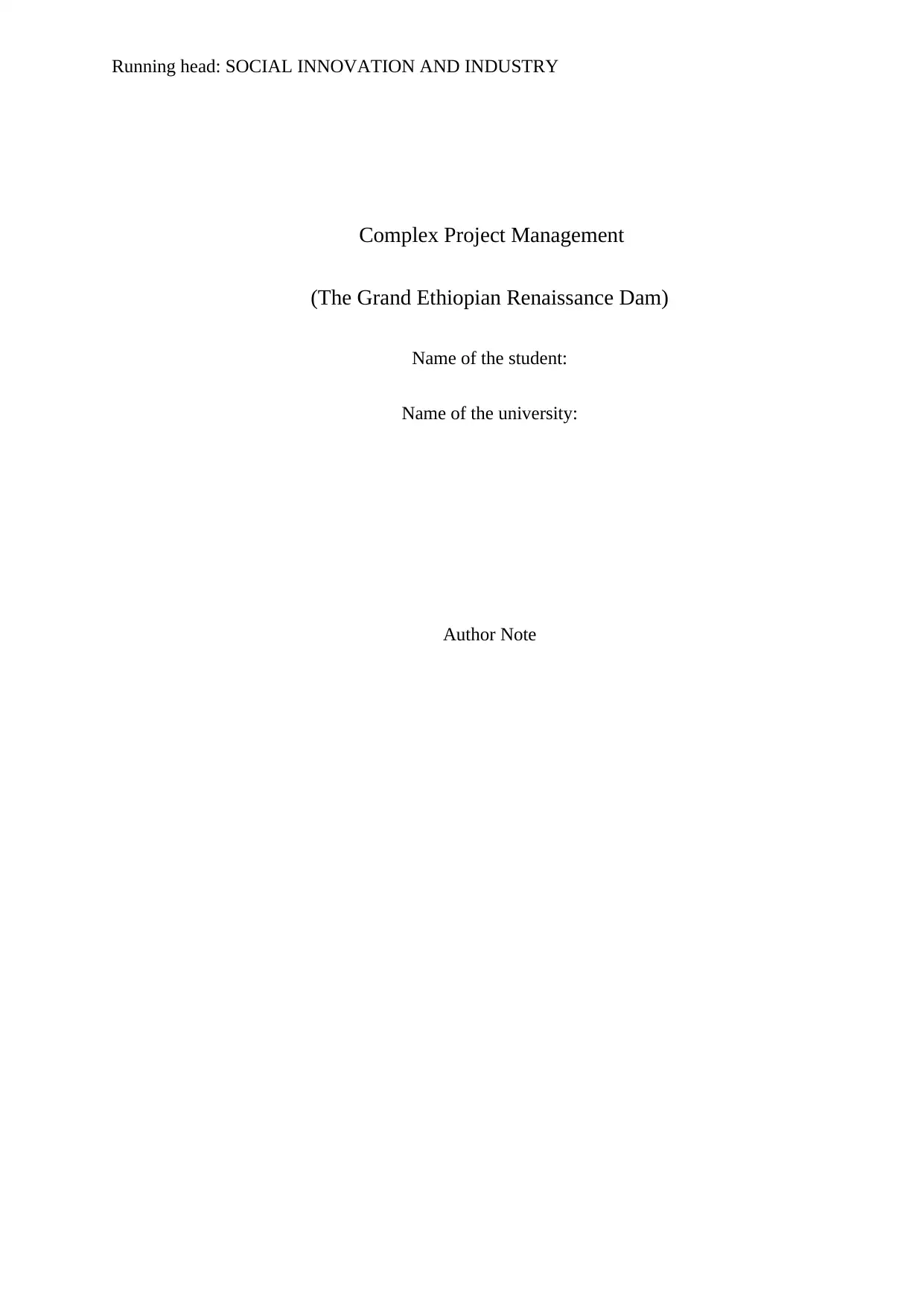
Running head: SOCIAL INNOVATION AND INDUSTRY
Complex Project Management
(The Grand Ethiopian Renaissance Dam)
Name of the student:
Name of the university:
Author Note
Complex Project Management
(The Grand Ethiopian Renaissance Dam)
Name of the student:
Name of the university:
Author Note
Paraphrase This Document
Need a fresh take? Get an instant paraphrase of this document with our AI Paraphraser
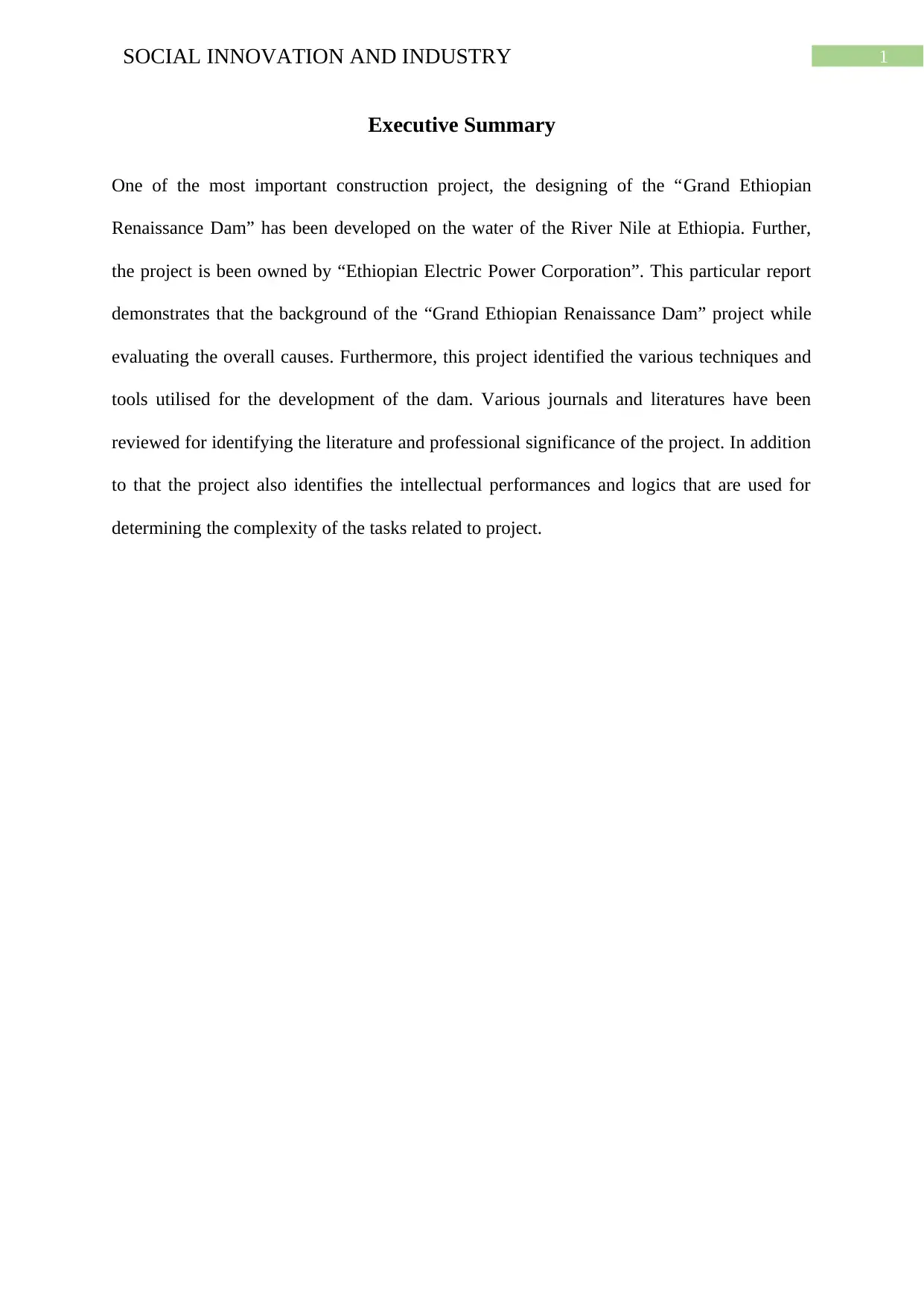
1SOCIAL INNOVATION AND INDUSTRY
Executive Summary
One of the most important construction project, the designing of the “Grand Ethiopian
Renaissance Dam” has been developed on the water of the River Nile at Ethiopia. Further,
the project is been owned by “Ethiopian Electric Power Corporation”. This particular report
demonstrates that the background of the “Grand Ethiopian Renaissance Dam” project while
evaluating the overall causes. Furthermore, this project identified the various techniques and
tools utilised for the development of the dam. Various journals and literatures have been
reviewed for identifying the literature and professional significance of the project. In addition
to that the project also identifies the intellectual performances and logics that are used for
determining the complexity of the tasks related to project.
Executive Summary
One of the most important construction project, the designing of the “Grand Ethiopian
Renaissance Dam” has been developed on the water of the River Nile at Ethiopia. Further,
the project is been owned by “Ethiopian Electric Power Corporation”. This particular report
demonstrates that the background of the “Grand Ethiopian Renaissance Dam” project while
evaluating the overall causes. Furthermore, this project identified the various techniques and
tools utilised for the development of the dam. Various journals and literatures have been
reviewed for identifying the literature and professional significance of the project. In addition
to that the project also identifies the intellectual performances and logics that are used for
determining the complexity of the tasks related to project.
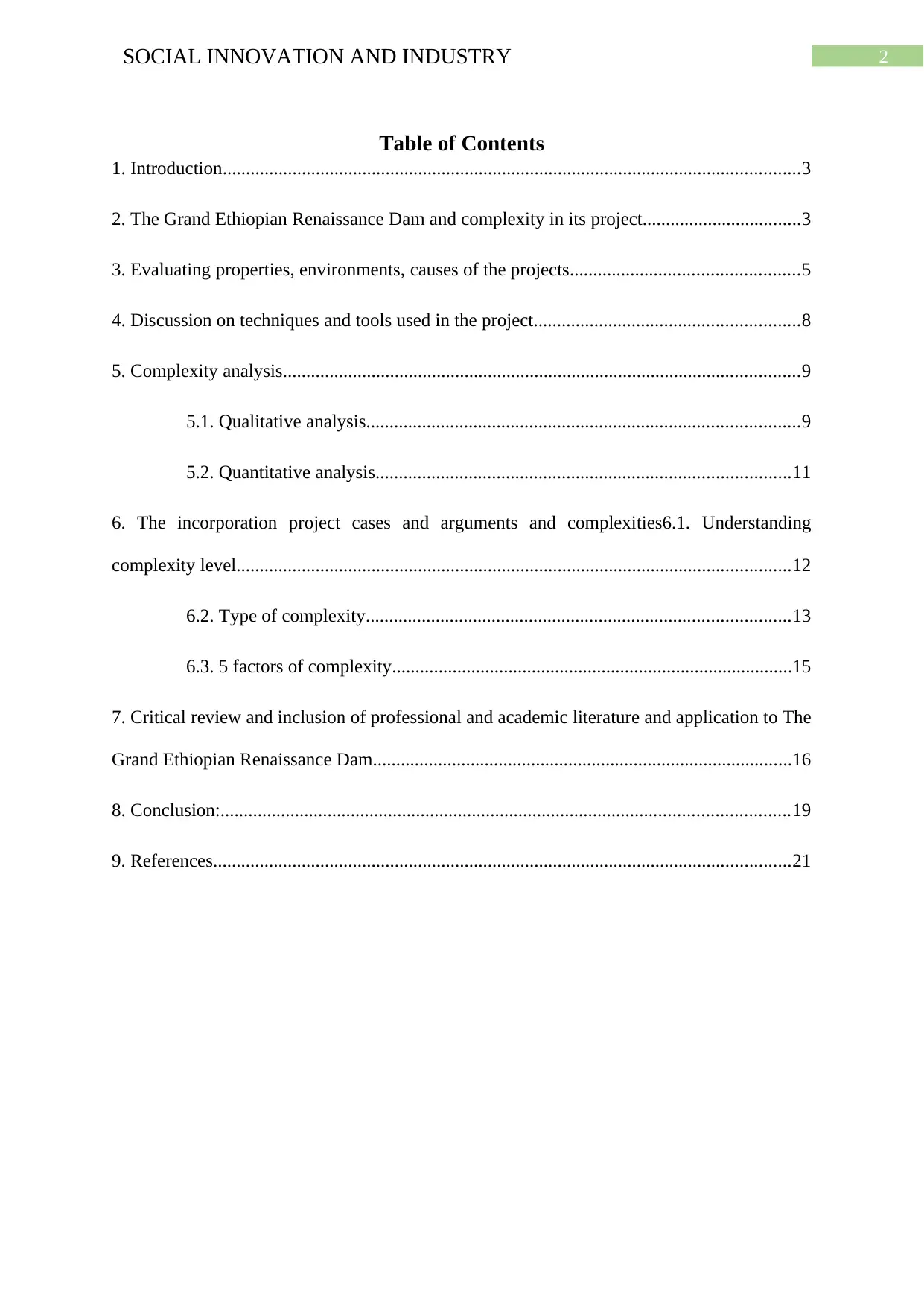
2SOCIAL INNOVATION AND INDUSTRY
Table of Contents
1. Introduction............................................................................................................................3
2. The Grand Ethiopian Renaissance Dam and complexity in its project..................................3
3. Evaluating properties, environments, causes of the projects.................................................5
4. Discussion on techniques and tools used in the project.........................................................8
5. Complexity analysis...............................................................................................................9
5.1. Qualitative analysis.............................................................................................9
5.2. Quantitative analysis.........................................................................................11
6. The incorporation project cases and arguments and complexities6.1. Understanding
complexity level.......................................................................................................................12
6.2. Type of complexity...........................................................................................13
6.3. 5 factors of complexity......................................................................................15
7. Critical review and inclusion of professional and academic literature and application to The
Grand Ethiopian Renaissance Dam..........................................................................................16
8. Conclusion:..........................................................................................................................19
9. References............................................................................................................................21
Table of Contents
1. Introduction............................................................................................................................3
2. The Grand Ethiopian Renaissance Dam and complexity in its project..................................3
3. Evaluating properties, environments, causes of the projects.................................................5
4. Discussion on techniques and tools used in the project.........................................................8
5. Complexity analysis...............................................................................................................9
5.1. Qualitative analysis.............................................................................................9
5.2. Quantitative analysis.........................................................................................11
6. The incorporation project cases and arguments and complexities6.1. Understanding
complexity level.......................................................................................................................12
6.2. Type of complexity...........................................................................................13
6.3. 5 factors of complexity......................................................................................15
7. Critical review and inclusion of professional and academic literature and application to The
Grand Ethiopian Renaissance Dam..........................................................................................16
8. Conclusion:..........................................................................................................................19
9. References............................................................................................................................21
⊘ This is a preview!⊘
Do you want full access?
Subscribe today to unlock all pages.

Trusted by 1+ million students worldwide
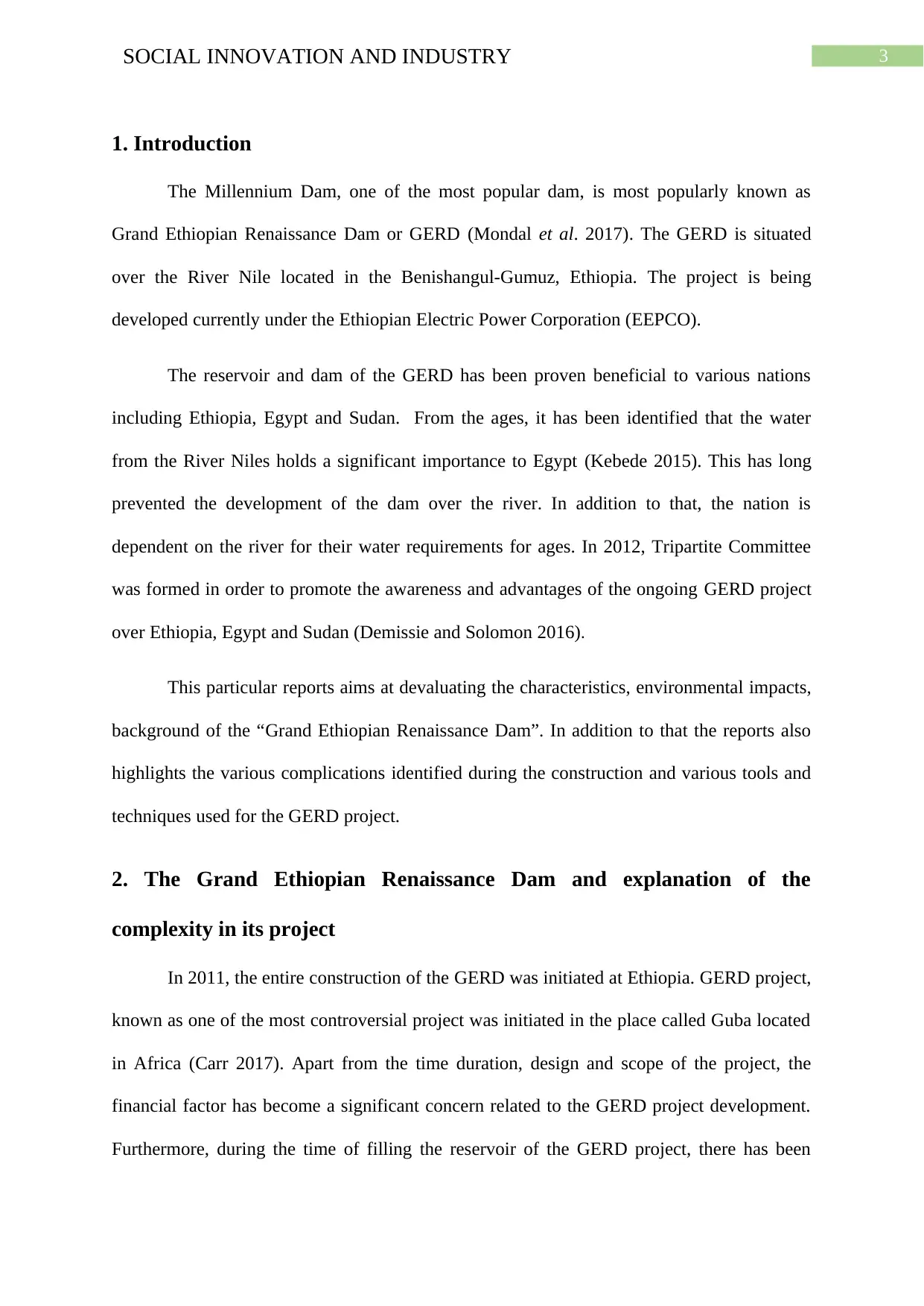
3SOCIAL INNOVATION AND INDUSTRY
1. Introduction
The Millennium Dam, one of the most popular dam, is most popularly known as
Grand Ethiopian Renaissance Dam or GERD (Mondal et al. 2017). The GERD is situated
over the River Nile located in the Benishangul-Gumuz, Ethiopia. The project is being
developed currently under the Ethiopian Electric Power Corporation (EEPCO).
The reservoir and dam of the GERD has been proven beneficial to various nations
including Ethiopia, Egypt and Sudan. From the ages, it has been identified that the water
from the River Niles holds a significant importance to Egypt (Kebede 2015). This has long
prevented the development of the dam over the river. In addition to that, the nation is
dependent on the river for their water requirements for ages. In 2012, Tripartite Committee
was formed in order to promote the awareness and advantages of the ongoing GERD project
over Ethiopia, Egypt and Sudan (Demissie and Solomon 2016).
This particular reports aims at devaluating the characteristics, environmental impacts,
background of the “Grand Ethiopian Renaissance Dam”. In addition to that the reports also
highlights the various complications identified during the construction and various tools and
techniques used for the GERD project.
2. The Grand Ethiopian Renaissance Dam and explanation of the
complexity in its project
In 2011, the entire construction of the GERD was initiated at Ethiopia. GERD project,
known as one of the most controversial project was initiated in the place called Guba located
in Africa (Carr 2017). Apart from the time duration, design and scope of the project, the
financial factor has become a significant concern related to the GERD project development.
Furthermore, during the time of filling the reservoir of the GERD project, there has been
1. Introduction
The Millennium Dam, one of the most popular dam, is most popularly known as
Grand Ethiopian Renaissance Dam or GERD (Mondal et al. 2017). The GERD is situated
over the River Nile located in the Benishangul-Gumuz, Ethiopia. The project is being
developed currently under the Ethiopian Electric Power Corporation (EEPCO).
The reservoir and dam of the GERD has been proven beneficial to various nations
including Ethiopia, Egypt and Sudan. From the ages, it has been identified that the water
from the River Niles holds a significant importance to Egypt (Kebede 2015). This has long
prevented the development of the dam over the river. In addition to that, the nation is
dependent on the river for their water requirements for ages. In 2012, Tripartite Committee
was formed in order to promote the awareness and advantages of the ongoing GERD project
over Ethiopia, Egypt and Sudan (Demissie and Solomon 2016).
This particular reports aims at devaluating the characteristics, environmental impacts,
background of the “Grand Ethiopian Renaissance Dam”. In addition to that the reports also
highlights the various complications identified during the construction and various tools and
techniques used for the GERD project.
2. The Grand Ethiopian Renaissance Dam and explanation of the
complexity in its project
In 2011, the entire construction of the GERD was initiated at Ethiopia. GERD project,
known as one of the most controversial project was initiated in the place called Guba located
in Africa (Carr 2017). Apart from the time duration, design and scope of the project, the
financial factor has become a significant concern related to the GERD project development.
Furthermore, during the time of filling the reservoir of the GERD project, there has been
Paraphrase This Document
Need a fresh take? Get an instant paraphrase of this document with our AI Paraphraser
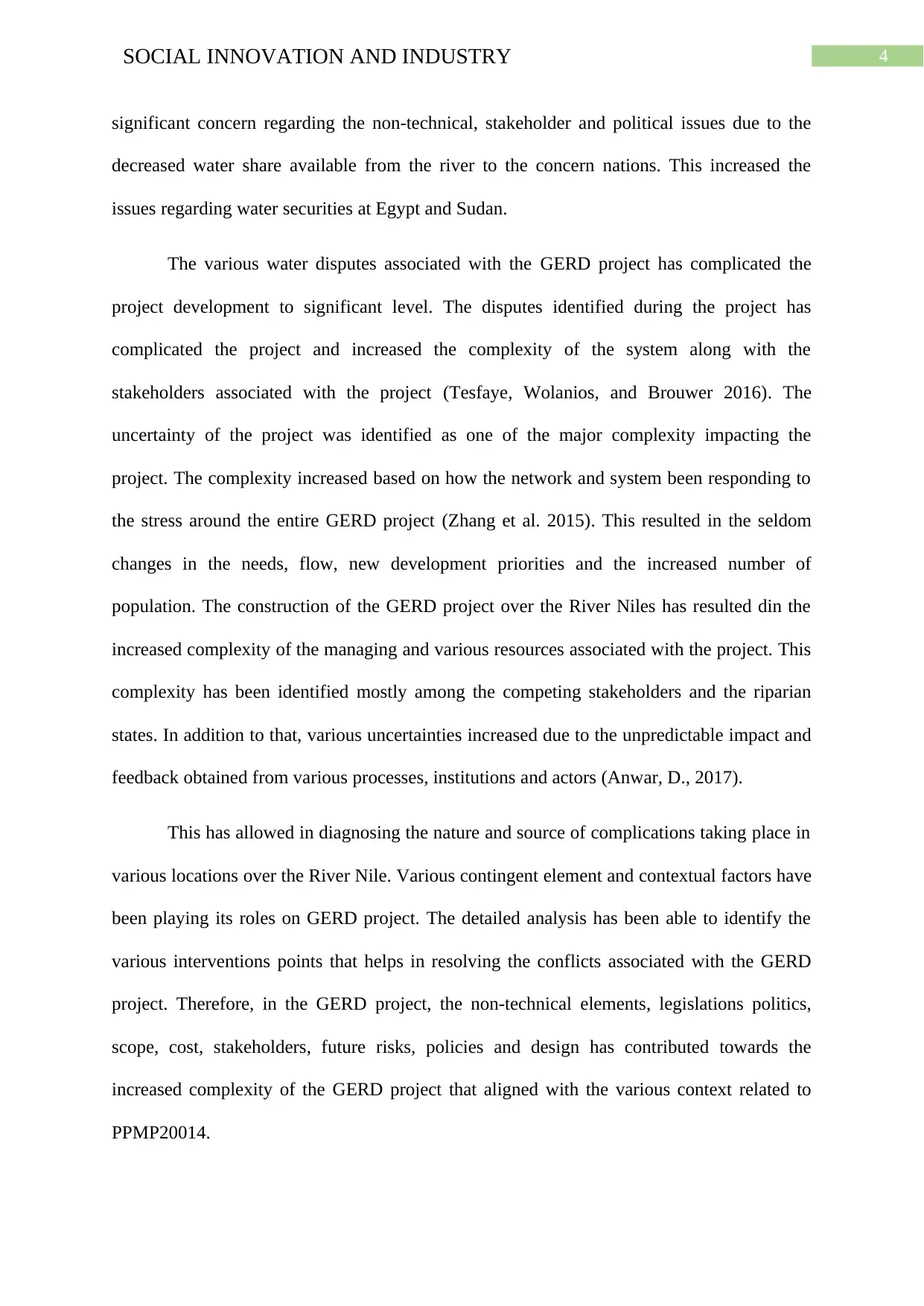
4SOCIAL INNOVATION AND INDUSTRY
significant concern regarding the non-technical, stakeholder and political issues due to the
decreased water share available from the river to the concern nations. This increased the
issues regarding water securities at Egypt and Sudan.
The various water disputes associated with the GERD project has complicated the
project development to significant level. The disputes identified during the project has
complicated the project and increased the complexity of the system along with the
stakeholders associated with the project (Tesfaye, Wolanios, and Brouwer 2016). The
uncertainty of the project was identified as one of the major complexity impacting the
project. The complexity increased based on how the network and system been responding to
the stress around the entire GERD project (Zhang et al. 2015). This resulted in the seldom
changes in the needs, flow, new development priorities and the increased number of
population. The construction of the GERD project over the River Niles has resulted din the
increased complexity of the managing and various resources associated with the project. This
complexity has been identified mostly among the competing stakeholders and the riparian
states. In addition to that, various uncertainties increased due to the unpredictable impact and
feedback obtained from various processes, institutions and actors (Anwar, D., 2017).
This has allowed in diagnosing the nature and source of complications taking place in
various locations over the River Nile. Various contingent element and contextual factors have
been playing its roles on GERD project. The detailed analysis has been able to identify the
various interventions points that helps in resolving the conflicts associated with the GERD
project. Therefore, in the GERD project, the non-technical elements, legislations politics,
scope, cost, stakeholders, future risks, policies and design has contributed towards the
increased complexity of the GERD project that aligned with the various context related to
PPMP20014.
significant concern regarding the non-technical, stakeholder and political issues due to the
decreased water share available from the river to the concern nations. This increased the
issues regarding water securities at Egypt and Sudan.
The various water disputes associated with the GERD project has complicated the
project development to significant level. The disputes identified during the project has
complicated the project and increased the complexity of the system along with the
stakeholders associated with the project (Tesfaye, Wolanios, and Brouwer 2016). The
uncertainty of the project was identified as one of the major complexity impacting the
project. The complexity increased based on how the network and system been responding to
the stress around the entire GERD project (Zhang et al. 2015). This resulted in the seldom
changes in the needs, flow, new development priorities and the increased number of
population. The construction of the GERD project over the River Niles has resulted din the
increased complexity of the managing and various resources associated with the project. This
complexity has been identified mostly among the competing stakeholders and the riparian
states. In addition to that, various uncertainties increased due to the unpredictable impact and
feedback obtained from various processes, institutions and actors (Anwar, D., 2017).
This has allowed in diagnosing the nature and source of complications taking place in
various locations over the River Nile. Various contingent element and contextual factors have
been playing its roles on GERD project. The detailed analysis has been able to identify the
various interventions points that helps in resolving the conflicts associated with the GERD
project. Therefore, in the GERD project, the non-technical elements, legislations politics,
scope, cost, stakeholders, future risks, policies and design has contributed towards the
increased complexity of the GERD project that aligned with the various context related to
PPMP20014.
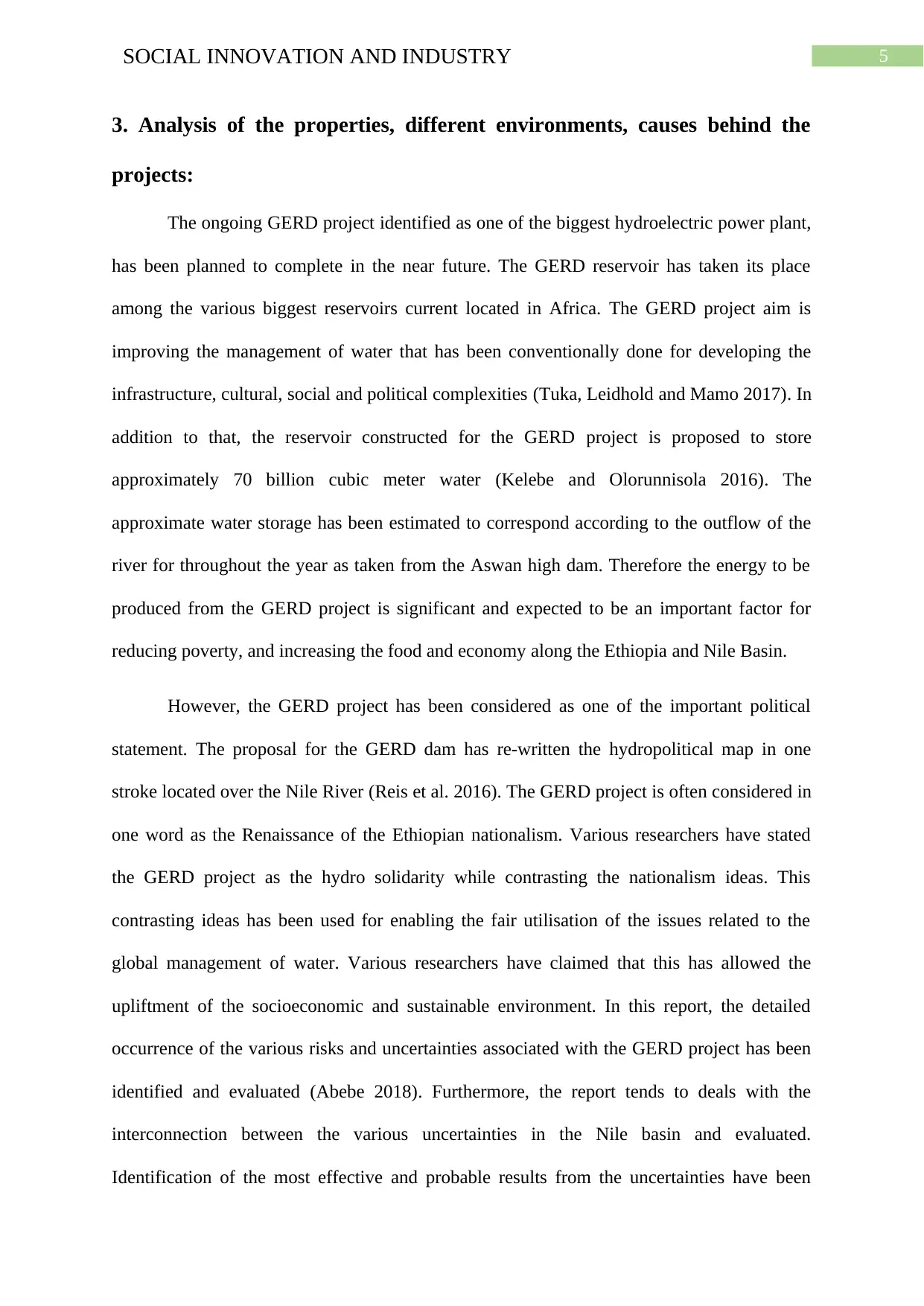
5SOCIAL INNOVATION AND INDUSTRY
3. Analysis of the properties, different environments, causes behind the
projects:
The ongoing GERD project identified as one of the biggest hydroelectric power plant,
has been planned to complete in the near future. The GERD reservoir has taken its place
among the various biggest reservoirs current located in Africa. The GERD project aim is
improving the management of water that has been conventionally done for developing the
infrastructure, cultural, social and political complexities (Tuka, Leidhold and Mamo 2017). In
addition to that, the reservoir constructed for the GERD project is proposed to store
approximately 70 billion cubic meter water (Kelebe and Olorunnisola 2016). The
approximate water storage has been estimated to correspond according to the outflow of the
river for throughout the year as taken from the Aswan high dam. Therefore the energy to be
produced from the GERD project is significant and expected to be an important factor for
reducing poverty, and increasing the food and economy along the Ethiopia and Nile Basin.
However, the GERD project has been considered as one of the important political
statement. The proposal for the GERD dam has re-written the hydropolitical map in one
stroke located over the Nile River (Reis et al. 2016). The GERD project is often considered in
one word as the Renaissance of the Ethiopian nationalism. Various researchers have stated
the GERD project as the hydro solidarity while contrasting the nationalism ideas. This
contrasting ideas has been used for enabling the fair utilisation of the issues related to the
global management of water. Various researchers have claimed that this has allowed the
upliftment of the socioeconomic and sustainable environment. In this report, the detailed
occurrence of the various risks and uncertainties associated with the GERD project has been
identified and evaluated (Abebe 2018). Furthermore, the report tends to deals with the
interconnection between the various uncertainties in the Nile basin and evaluated.
Identification of the most effective and probable results from the uncertainties have been
3. Analysis of the properties, different environments, causes behind the
projects:
The ongoing GERD project identified as one of the biggest hydroelectric power plant,
has been planned to complete in the near future. The GERD reservoir has taken its place
among the various biggest reservoirs current located in Africa. The GERD project aim is
improving the management of water that has been conventionally done for developing the
infrastructure, cultural, social and political complexities (Tuka, Leidhold and Mamo 2017). In
addition to that, the reservoir constructed for the GERD project is proposed to store
approximately 70 billion cubic meter water (Kelebe and Olorunnisola 2016). The
approximate water storage has been estimated to correspond according to the outflow of the
river for throughout the year as taken from the Aswan high dam. Therefore the energy to be
produced from the GERD project is significant and expected to be an important factor for
reducing poverty, and increasing the food and economy along the Ethiopia and Nile Basin.
However, the GERD project has been considered as one of the important political
statement. The proposal for the GERD dam has re-written the hydropolitical map in one
stroke located over the Nile River (Reis et al. 2016). The GERD project is often considered in
one word as the Renaissance of the Ethiopian nationalism. Various researchers have stated
the GERD project as the hydro solidarity while contrasting the nationalism ideas. This
contrasting ideas has been used for enabling the fair utilisation of the issues related to the
global management of water. Various researchers have claimed that this has allowed the
upliftment of the socioeconomic and sustainable environment. In this report, the detailed
occurrence of the various risks and uncertainties associated with the GERD project has been
identified and evaluated (Abebe 2018). Furthermore, the report tends to deals with the
interconnection between the various uncertainties in the Nile basin and evaluated.
Identification of the most effective and probable results from the uncertainties have been
⊘ This is a preview!⊘
Do you want full access?
Subscribe today to unlock all pages.

Trusted by 1+ million students worldwide
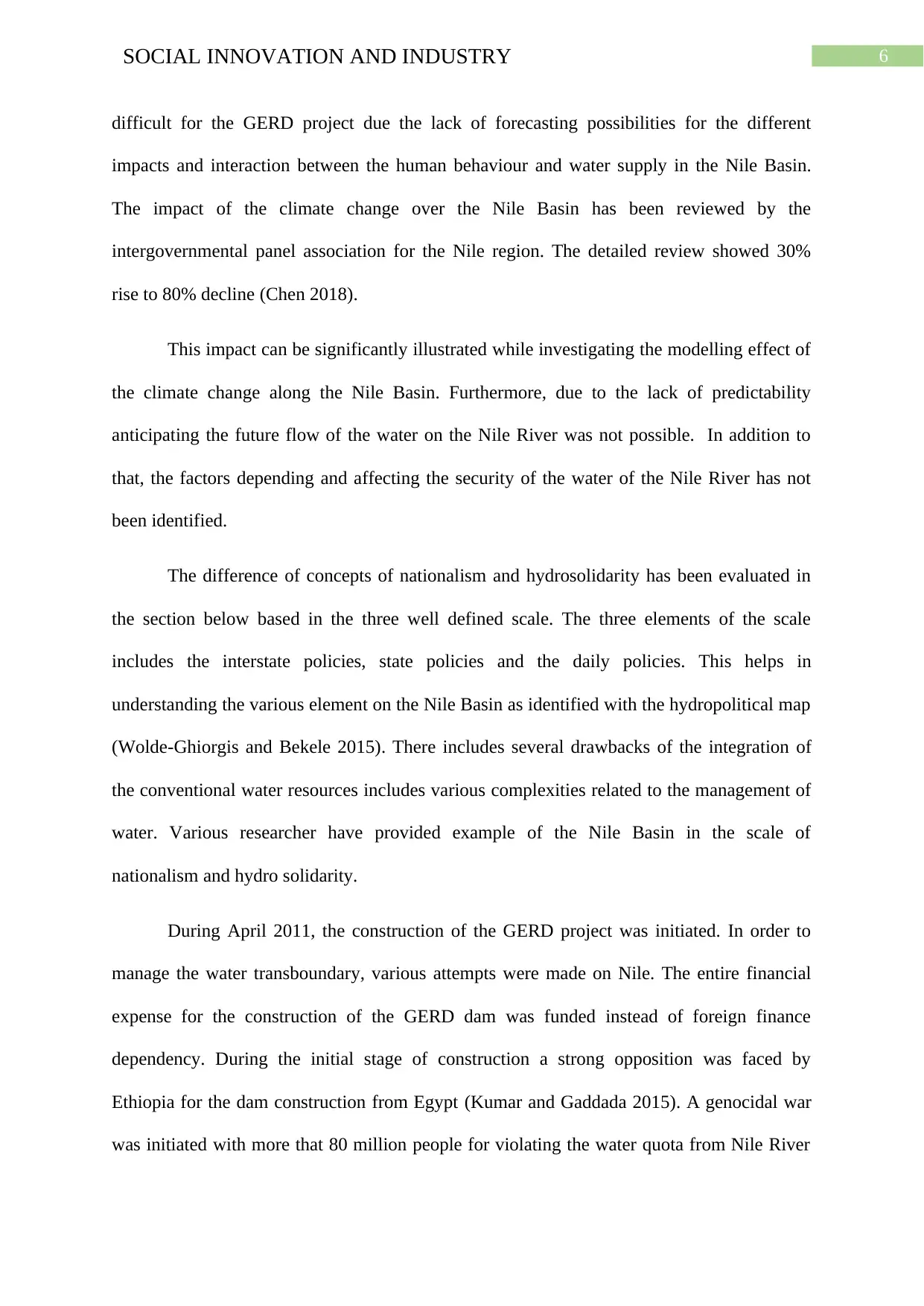
6SOCIAL INNOVATION AND INDUSTRY
difficult for the GERD project due the lack of forecasting possibilities for the different
impacts and interaction between the human behaviour and water supply in the Nile Basin.
The impact of the climate change over the Nile Basin has been reviewed by the
intergovernmental panel association for the Nile region. The detailed review showed 30%
rise to 80% decline (Chen 2018).
This impact can be significantly illustrated while investigating the modelling effect of
the climate change along the Nile Basin. Furthermore, due to the lack of predictability
anticipating the future flow of the water on the Nile River was not possible. In addition to
that, the factors depending and affecting the security of the water of the Nile River has not
been identified.
The difference of concepts of nationalism and hydrosolidarity has been evaluated in
the section below based in the three well defined scale. The three elements of the scale
includes the interstate policies, state policies and the daily policies. This helps in
understanding the various element on the Nile Basin as identified with the hydropolitical map
(Wolde-Ghiorgis and Bekele 2015). There includes several drawbacks of the integration of
the conventional water resources includes various complexities related to the management of
water. Various researcher have provided example of the Nile Basin in the scale of
nationalism and hydro solidarity.
During April 2011, the construction of the GERD project was initiated. In order to
manage the water transboundary, various attempts were made on Nile. The entire financial
expense for the construction of the GERD dam was funded instead of foreign finance
dependency. During the initial stage of construction a strong opposition was faced by
Ethiopia for the dam construction from Egypt (Kumar and Gaddada 2015). A genocidal war
was initiated with more that 80 million people for violating the water quota from Nile River
difficult for the GERD project due the lack of forecasting possibilities for the different
impacts and interaction between the human behaviour and water supply in the Nile Basin.
The impact of the climate change over the Nile Basin has been reviewed by the
intergovernmental panel association for the Nile region. The detailed review showed 30%
rise to 80% decline (Chen 2018).
This impact can be significantly illustrated while investigating the modelling effect of
the climate change along the Nile Basin. Furthermore, due to the lack of predictability
anticipating the future flow of the water on the Nile River was not possible. In addition to
that, the factors depending and affecting the security of the water of the Nile River has not
been identified.
The difference of concepts of nationalism and hydrosolidarity has been evaluated in
the section below based in the three well defined scale. The three elements of the scale
includes the interstate policies, state policies and the daily policies. This helps in
understanding the various element on the Nile Basin as identified with the hydropolitical map
(Wolde-Ghiorgis and Bekele 2015). There includes several drawbacks of the integration of
the conventional water resources includes various complexities related to the management of
water. Various researcher have provided example of the Nile Basin in the scale of
nationalism and hydro solidarity.
During April 2011, the construction of the GERD project was initiated. In order to
manage the water transboundary, various attempts were made on Nile. The entire financial
expense for the construction of the GERD dam was funded instead of foreign finance
dependency. During the initial stage of construction a strong opposition was faced by
Ethiopia for the dam construction from Egypt (Kumar and Gaddada 2015). A genocidal war
was initiated with more that 80 million people for violating the water quota from Nile River
Paraphrase This Document
Need a fresh take? Get an instant paraphrase of this document with our AI Paraphraser
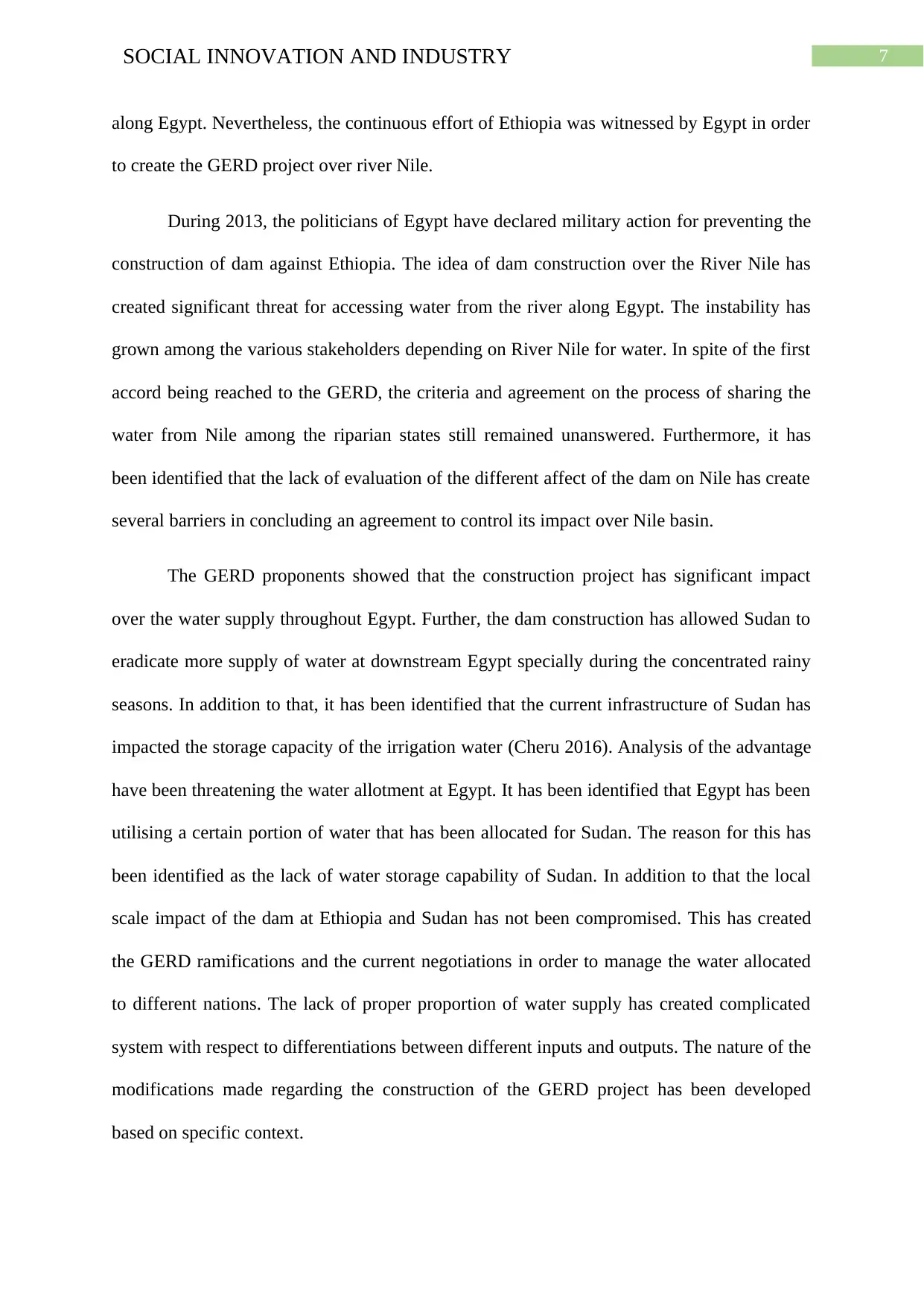
7SOCIAL INNOVATION AND INDUSTRY
along Egypt. Nevertheless, the continuous effort of Ethiopia was witnessed by Egypt in order
to create the GERD project over river Nile.
During 2013, the politicians of Egypt have declared military action for preventing the
construction of dam against Ethiopia. The idea of dam construction over the River Nile has
created significant threat for accessing water from the river along Egypt. The instability has
grown among the various stakeholders depending on River Nile for water. In spite of the first
accord being reached to the GERD, the criteria and agreement on the process of sharing the
water from Nile among the riparian states still remained unanswered. Furthermore, it has
been identified that the lack of evaluation of the different affect of the dam on Nile has create
several barriers in concluding an agreement to control its impact over Nile basin.
The GERD proponents showed that the construction project has significant impact
over the water supply throughout Egypt. Further, the dam construction has allowed Sudan to
eradicate more supply of water at downstream Egypt specially during the concentrated rainy
seasons. In addition to that, it has been identified that the current infrastructure of Sudan has
impacted the storage capacity of the irrigation water (Cheru 2016). Analysis of the advantage
have been threatening the water allotment at Egypt. It has been identified that Egypt has been
utilising a certain portion of water that has been allocated for Sudan. The reason for this has
been identified as the lack of water storage capability of Sudan. In addition to that the local
scale impact of the dam at Ethiopia and Sudan has not been compromised. This has created
the GERD ramifications and the current negotiations in order to manage the water allocated
to different nations. The lack of proper proportion of water supply has created complicated
system with respect to differentiations between different inputs and outputs. The nature of the
modifications made regarding the construction of the GERD project has been developed
based on specific context.
along Egypt. Nevertheless, the continuous effort of Ethiopia was witnessed by Egypt in order
to create the GERD project over river Nile.
During 2013, the politicians of Egypt have declared military action for preventing the
construction of dam against Ethiopia. The idea of dam construction over the River Nile has
created significant threat for accessing water from the river along Egypt. The instability has
grown among the various stakeholders depending on River Nile for water. In spite of the first
accord being reached to the GERD, the criteria and agreement on the process of sharing the
water from Nile among the riparian states still remained unanswered. Furthermore, it has
been identified that the lack of evaluation of the different affect of the dam on Nile has create
several barriers in concluding an agreement to control its impact over Nile basin.
The GERD proponents showed that the construction project has significant impact
over the water supply throughout Egypt. Further, the dam construction has allowed Sudan to
eradicate more supply of water at downstream Egypt specially during the concentrated rainy
seasons. In addition to that, it has been identified that the current infrastructure of Sudan has
impacted the storage capacity of the irrigation water (Cheru 2016). Analysis of the advantage
have been threatening the water allotment at Egypt. It has been identified that Egypt has been
utilising a certain portion of water that has been allocated for Sudan. The reason for this has
been identified as the lack of water storage capability of Sudan. In addition to that the local
scale impact of the dam at Ethiopia and Sudan has not been compromised. This has created
the GERD ramifications and the current negotiations in order to manage the water allocated
to different nations. The lack of proper proportion of water supply has created complicated
system with respect to differentiations between different inputs and outputs. The nature of the
modifications made regarding the construction of the GERD project has been developed
based on specific context.
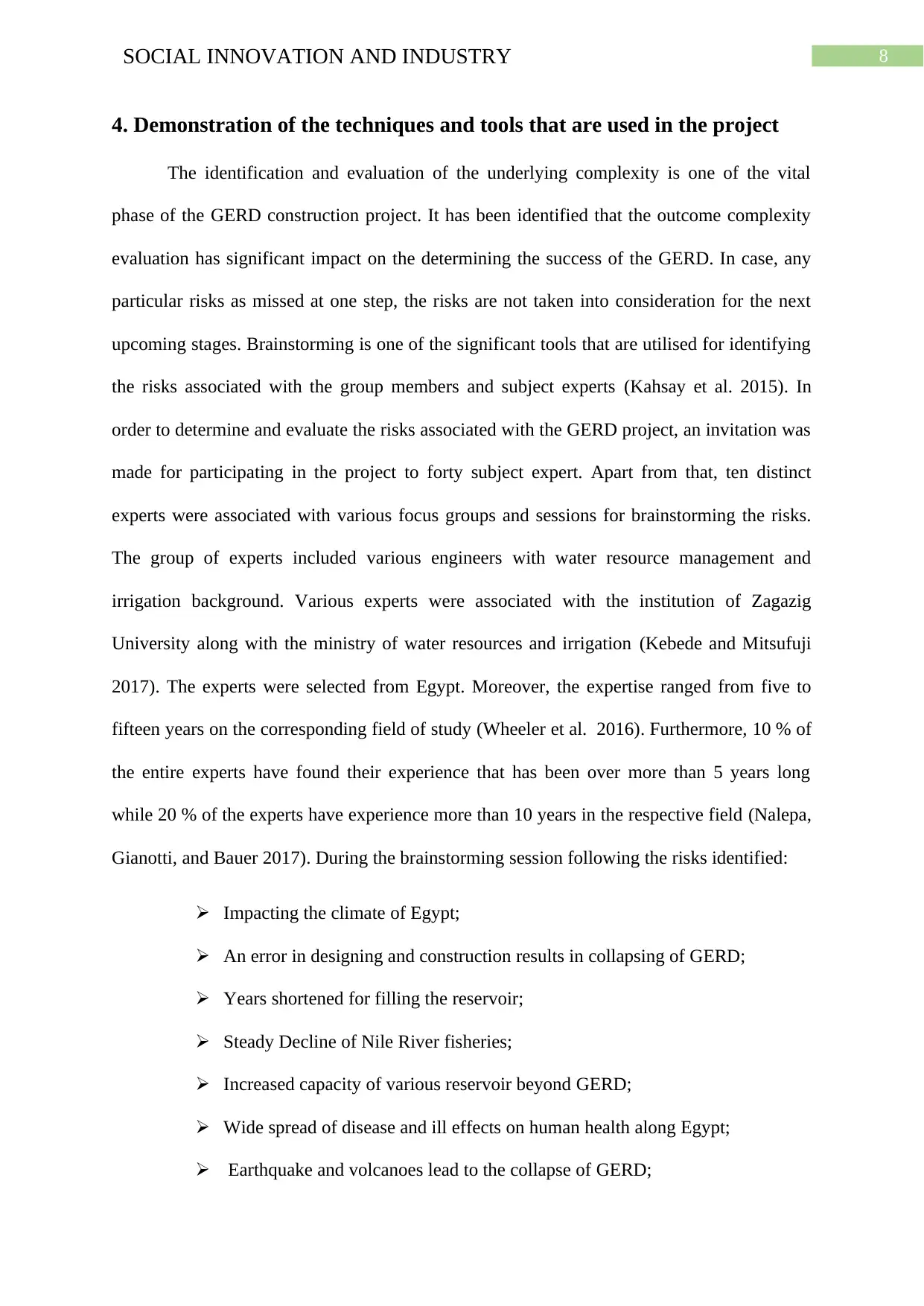
8SOCIAL INNOVATION AND INDUSTRY
4. Demonstration of the techniques and tools that are used in the project
The identification and evaluation of the underlying complexity is one of the vital
phase of the GERD construction project. It has been identified that the outcome complexity
evaluation has significant impact on the determining the success of the GERD. In case, any
particular risks as missed at one step, the risks are not taken into consideration for the next
upcoming stages. Brainstorming is one of the significant tools that are utilised for identifying
the risks associated with the group members and subject experts (Kahsay et al. 2015). In
order to determine and evaluate the risks associated with the GERD project, an invitation was
made for participating in the project to forty subject expert. Apart from that, ten distinct
experts were associated with various focus groups and sessions for brainstorming the risks.
The group of experts included various engineers with water resource management and
irrigation background. Various experts were associated with the institution of Zagazig
University along with the ministry of water resources and irrigation (Kebede and Mitsufuji
2017). The experts were selected from Egypt. Moreover, the expertise ranged from five to
fifteen years on the corresponding field of study (Wheeler et al. 2016). Furthermore, 10 % of
the entire experts have found their experience that has been over more than 5 years long
while 20 % of the experts have experience more than 10 years in the respective field (Nalepa,
Gianotti, and Bauer 2017). During the brainstorming session following the risks identified:
Impacting the climate of Egypt;
An error in designing and construction results in collapsing of GERD;
Years shortened for filling the reservoir;
Steady Decline of Nile River fisheries;
Increased capacity of various reservoir beyond GERD;
Wide spread of disease and ill effects on human health along Egypt;
Earthquake and volcanoes lead to the collapse of GERD;
4. Demonstration of the techniques and tools that are used in the project
The identification and evaluation of the underlying complexity is one of the vital
phase of the GERD construction project. It has been identified that the outcome complexity
evaluation has significant impact on the determining the success of the GERD. In case, any
particular risks as missed at one step, the risks are not taken into consideration for the next
upcoming stages. Brainstorming is one of the significant tools that are utilised for identifying
the risks associated with the group members and subject experts (Kahsay et al. 2015). In
order to determine and evaluate the risks associated with the GERD project, an invitation was
made for participating in the project to forty subject expert. Apart from that, ten distinct
experts were associated with various focus groups and sessions for brainstorming the risks.
The group of experts included various engineers with water resource management and
irrigation background. Various experts were associated with the institution of Zagazig
University along with the ministry of water resources and irrigation (Kebede and Mitsufuji
2017). The experts were selected from Egypt. Moreover, the expertise ranged from five to
fifteen years on the corresponding field of study (Wheeler et al. 2016). Furthermore, 10 % of
the entire experts have found their experience that has been over more than 5 years long
while 20 % of the experts have experience more than 10 years in the respective field (Nalepa,
Gianotti, and Bauer 2017). During the brainstorming session following the risks identified:
Impacting the climate of Egypt;
An error in designing and construction results in collapsing of GERD;
Years shortened for filling the reservoir;
Steady Decline of Nile River fisheries;
Increased capacity of various reservoir beyond GERD;
Wide spread of disease and ill effects on human health along Egypt;
Earthquake and volcanoes lead to the collapse of GERD;
⊘ This is a preview!⊘
Do you want full access?
Subscribe today to unlock all pages.

Trusted by 1+ million students worldwide
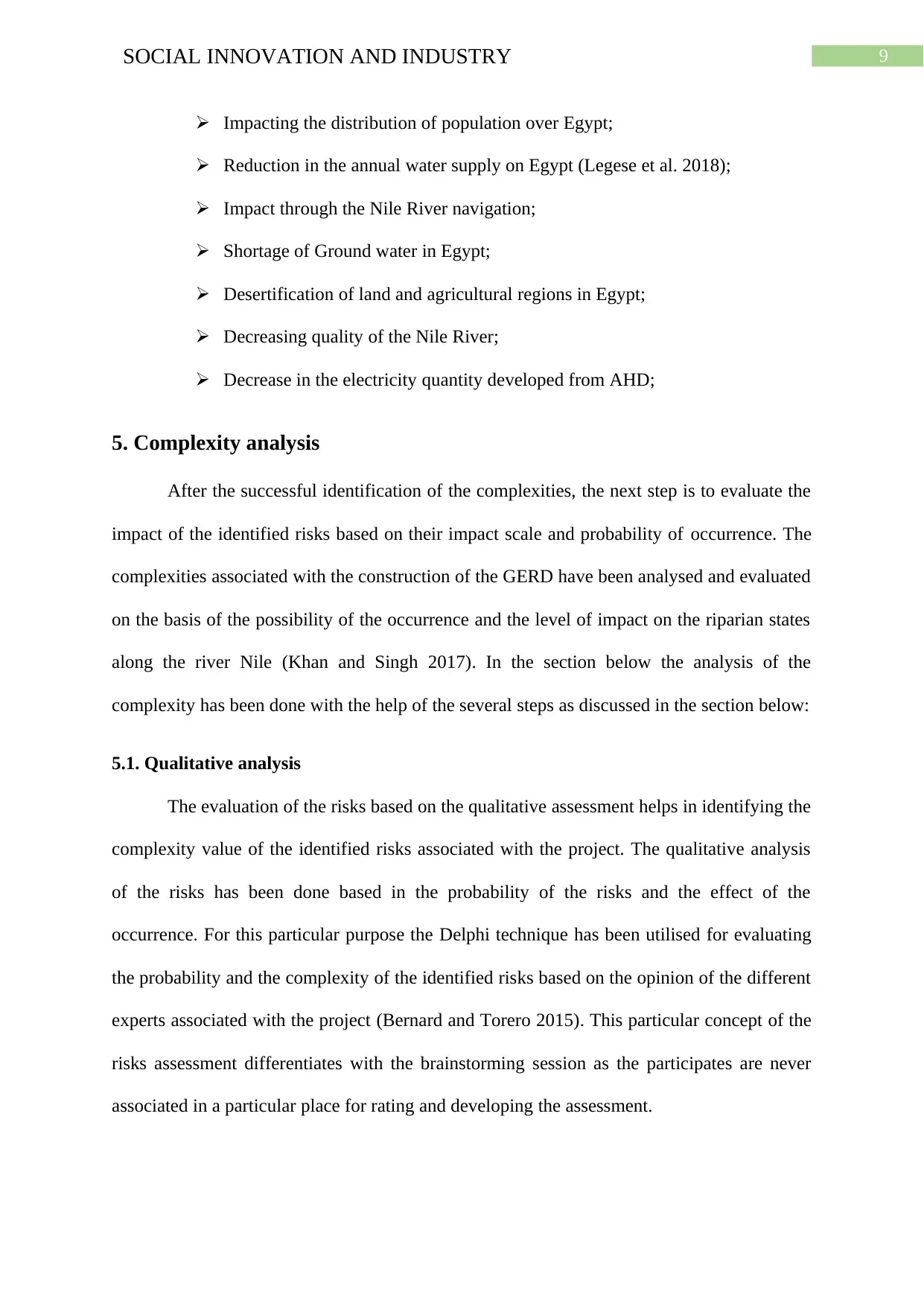
9SOCIAL INNOVATION AND INDUSTRY
Impacting the distribution of population over Egypt;
Reduction in the annual water supply on Egypt (Legese et al. 2018);
Impact through the Nile River navigation;
Shortage of Ground water in Egypt;
Desertification of land and agricultural regions in Egypt;
Decreasing quality of the Nile River;
Decrease in the electricity quantity developed from AHD;
5. Complexity analysis
After the successful identification of the complexities, the next step is to evaluate the
impact of the identified risks based on their impact scale and probability of occurrence. The
complexities associated with the construction of the GERD have been analysed and evaluated
on the basis of the possibility of the occurrence and the level of impact on the riparian states
along the river Nile (Khan and Singh 2017). In the section below the analysis of the
complexity has been done with the help of the several steps as discussed in the section below:
5.1. Qualitative analysis
The evaluation of the risks based on the qualitative assessment helps in identifying the
complexity value of the identified risks associated with the project. The qualitative analysis
of the risks has been done based in the probability of the risks and the effect of the
occurrence. For this particular purpose the Delphi technique has been utilised for evaluating
the probability and the complexity of the identified risks based on the opinion of the different
experts associated with the project (Bernard and Torero 2015). This particular concept of the
risks assessment differentiates with the brainstorming session as the participates are never
associated in a particular place for rating and developing the assessment.
Impacting the distribution of population over Egypt;
Reduction in the annual water supply on Egypt (Legese et al. 2018);
Impact through the Nile River navigation;
Shortage of Ground water in Egypt;
Desertification of land and agricultural regions in Egypt;
Decreasing quality of the Nile River;
Decrease in the electricity quantity developed from AHD;
5. Complexity analysis
After the successful identification of the complexities, the next step is to evaluate the
impact of the identified risks based on their impact scale and probability of occurrence. The
complexities associated with the construction of the GERD have been analysed and evaluated
on the basis of the possibility of the occurrence and the level of impact on the riparian states
along the river Nile (Khan and Singh 2017). In the section below the analysis of the
complexity has been done with the help of the several steps as discussed in the section below:
5.1. Qualitative analysis
The evaluation of the risks based on the qualitative assessment helps in identifying the
complexity value of the identified risks associated with the project. The qualitative analysis
of the risks has been done based in the probability of the risks and the effect of the
occurrence. For this particular purpose the Delphi technique has been utilised for evaluating
the probability and the complexity of the identified risks based on the opinion of the different
experts associated with the project (Bernard and Torero 2015). This particular concept of the
risks assessment differentiates with the brainstorming session as the participates are never
associated in a particular place for rating and developing the assessment.
Paraphrase This Document
Need a fresh take? Get an instant paraphrase of this document with our AI Paraphraser
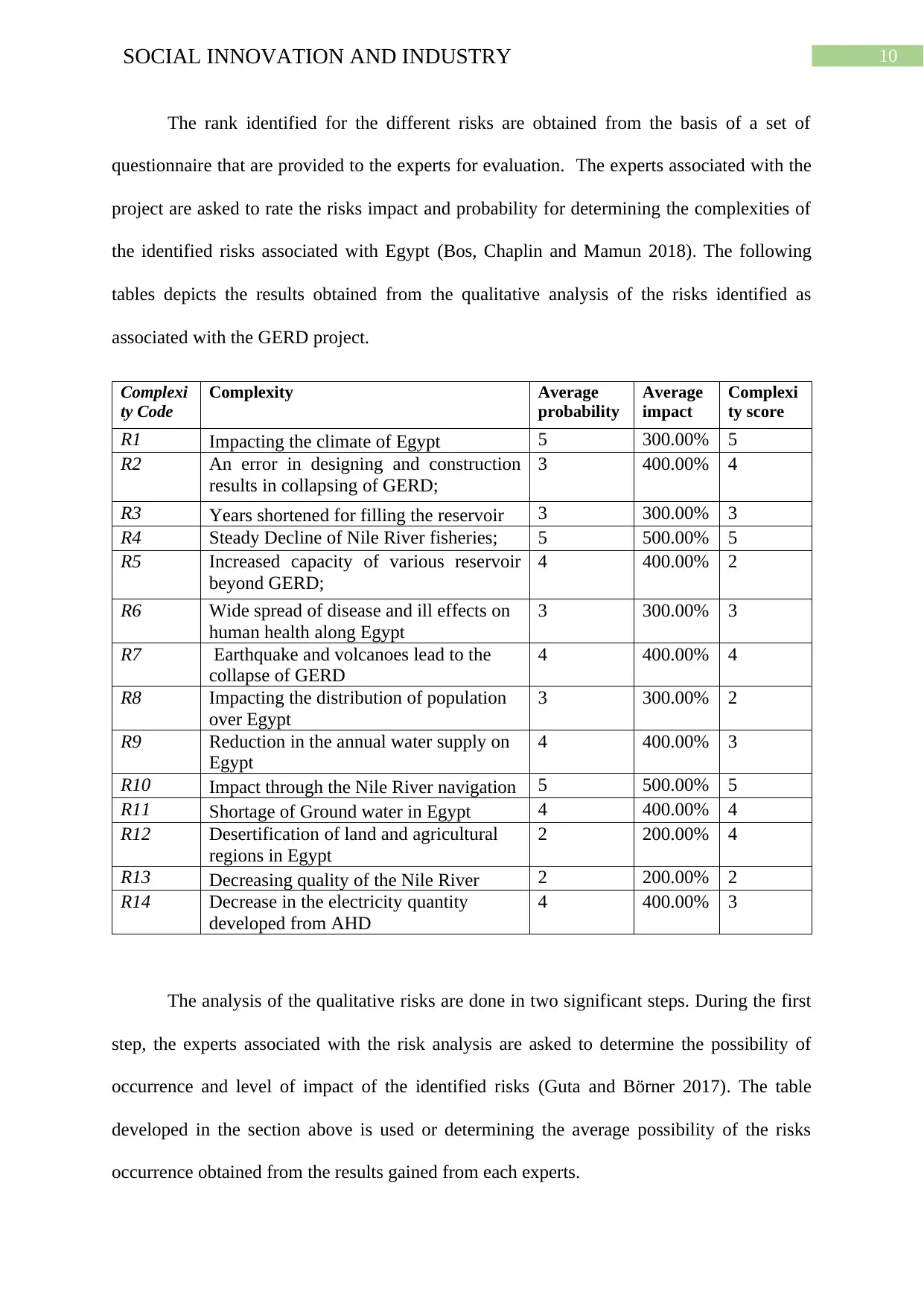
10SOCIAL INNOVATION AND INDUSTRY
The rank identified for the different risks are obtained from the basis of a set of
questionnaire that are provided to the experts for evaluation. The experts associated with the
project are asked to rate the risks impact and probability for determining the complexities of
the identified risks associated with Egypt (Bos, Chaplin and Mamun 2018). The following
tables depicts the results obtained from the qualitative analysis of the risks identified as
associated with the GERD project.
Complexi
ty Code
Complexity Average
probability
Average
impact
Complexi
ty score
R1 Impacting the climate of Egypt 5 300.00% 5
R2 An error in designing and construction
results in collapsing of GERD;
3 400.00% 4
R3 Years shortened for filling the reservoir 3 300.00% 3
R4 Steady Decline of Nile River fisheries; 5 500.00% 5
R5 Increased capacity of various reservoir
beyond GERD;
4 400.00% 2
R6 Wide spread of disease and ill effects on
human health along Egypt
3 300.00% 3
R7 Earthquake and volcanoes lead to the
collapse of GERD
4 400.00% 4
R8 Impacting the distribution of population
over Egypt
3 300.00% 2
R9 Reduction in the annual water supply on
Egypt
4 400.00% 3
R10 Impact through the Nile River navigation 5 500.00% 5
R11 Shortage of Ground water in Egypt 4 400.00% 4
R12 Desertification of land and agricultural
regions in Egypt
2 200.00% 4
R13 Decreasing quality of the Nile River 2 200.00% 2
R14 Decrease in the electricity quantity
developed from AHD
4 400.00% 3
The analysis of the qualitative risks are done in two significant steps. During the first
step, the experts associated with the risk analysis are asked to determine the possibility of
occurrence and level of impact of the identified risks (Guta and Börner 2017). The table
developed in the section above is used or determining the average possibility of the risks
occurrence obtained from the results gained from each experts.
The rank identified for the different risks are obtained from the basis of a set of
questionnaire that are provided to the experts for evaluation. The experts associated with the
project are asked to rate the risks impact and probability for determining the complexities of
the identified risks associated with Egypt (Bos, Chaplin and Mamun 2018). The following
tables depicts the results obtained from the qualitative analysis of the risks identified as
associated with the GERD project.
Complexi
ty Code
Complexity Average
probability
Average
impact
Complexi
ty score
R1 Impacting the climate of Egypt 5 300.00% 5
R2 An error in designing and construction
results in collapsing of GERD;
3 400.00% 4
R3 Years shortened for filling the reservoir 3 300.00% 3
R4 Steady Decline of Nile River fisheries; 5 500.00% 5
R5 Increased capacity of various reservoir
beyond GERD;
4 400.00% 2
R6 Wide spread of disease and ill effects on
human health along Egypt
3 300.00% 3
R7 Earthquake and volcanoes lead to the
collapse of GERD
4 400.00% 4
R8 Impacting the distribution of population
over Egypt
3 300.00% 2
R9 Reduction in the annual water supply on
Egypt
4 400.00% 3
R10 Impact through the Nile River navigation 5 500.00% 5
R11 Shortage of Ground water in Egypt 4 400.00% 4
R12 Desertification of land and agricultural
regions in Egypt
2 200.00% 4
R13 Decreasing quality of the Nile River 2 200.00% 2
R14 Decrease in the electricity quantity
developed from AHD
4 400.00% 3
The analysis of the qualitative risks are done in two significant steps. During the first
step, the experts associated with the risk analysis are asked to determine the possibility of
occurrence and level of impact of the identified risks (Guta and Börner 2017). The table
developed in the section above is used or determining the average possibility of the risks
occurrence obtained from the results gained from each experts.
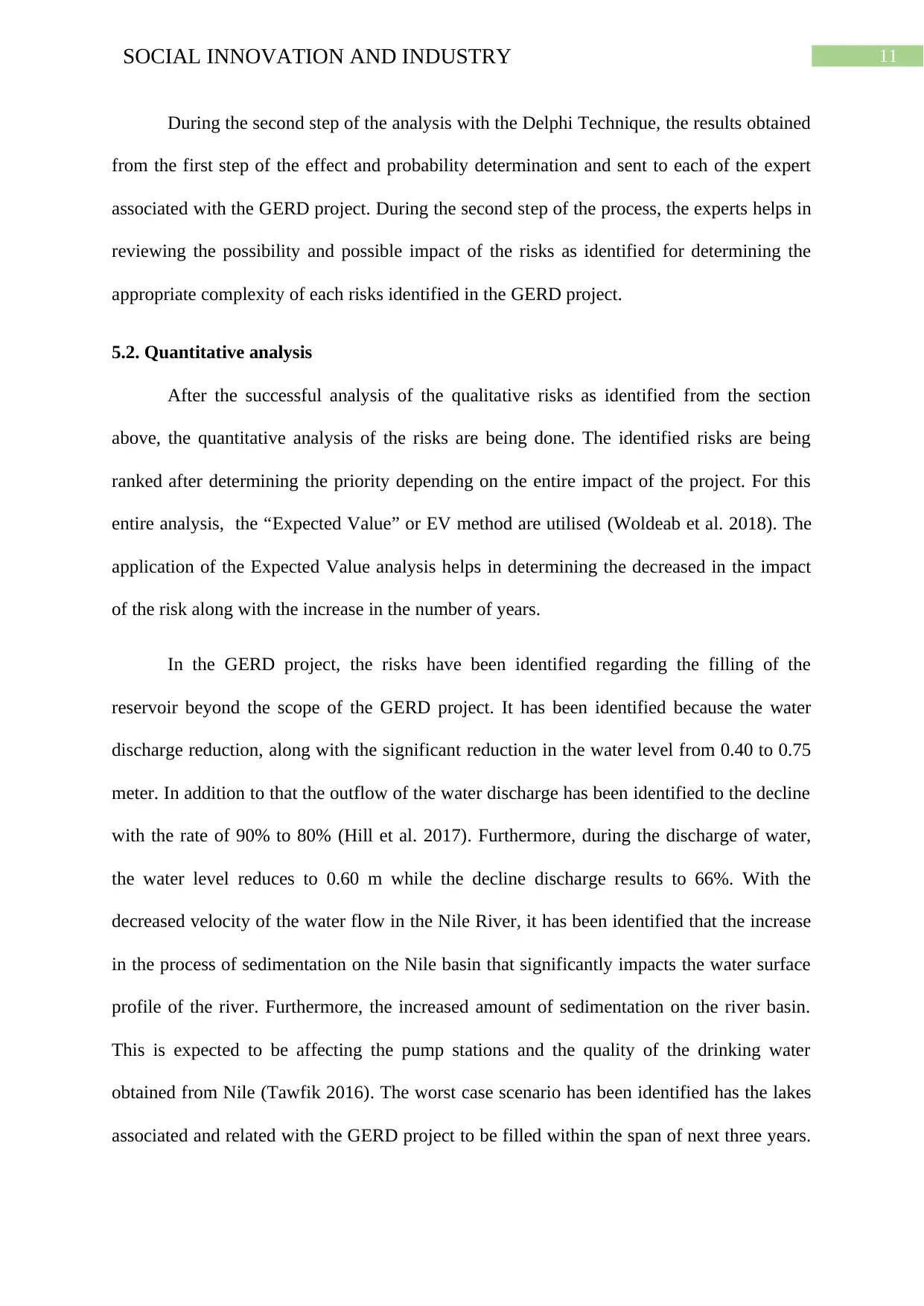
11SOCIAL INNOVATION AND INDUSTRY
During the second step of the analysis with the Delphi Technique, the results obtained
from the first step of the effect and probability determination and sent to each of the expert
associated with the GERD project. During the second step of the process, the experts helps in
reviewing the possibility and possible impact of the risks as identified for determining the
appropriate complexity of each risks identified in the GERD project.
5.2. Quantitative analysis
After the successful analysis of the qualitative risks as identified from the section
above, the quantitative analysis of the risks are being done. The identified risks are being
ranked after determining the priority depending on the entire impact of the project. For this
entire analysis, the “Expected Value” or EV method are utilised (Woldeab et al. 2018). The
application of the Expected Value analysis helps in determining the decreased in the impact
of the risk along with the increase in the number of years.
In the GERD project, the risks have been identified regarding the filling of the
reservoir beyond the scope of the GERD project. It has been identified because the water
discharge reduction, along with the significant reduction in the water level from 0.40 to 0.75
meter. In addition to that the outflow of the water discharge has been identified to the decline
with the rate of 90% to 80% (Hill et al. 2017). Furthermore, during the discharge of water,
the water level reduces to 0.60 m while the decline discharge results to 66%. With the
decreased velocity of the water flow in the Nile River, it has been identified that the increase
in the process of sedimentation on the Nile basin that significantly impacts the water surface
profile of the river. Furthermore, the increased amount of sedimentation on the river basin.
This is expected to be affecting the pump stations and the quality of the drinking water
obtained from Nile (Tawfik 2016). The worst case scenario has been identified has the lakes
associated and related with the GERD project to be filled within the span of next three years.
During the second step of the analysis with the Delphi Technique, the results obtained
from the first step of the effect and probability determination and sent to each of the expert
associated with the GERD project. During the second step of the process, the experts helps in
reviewing the possibility and possible impact of the risks as identified for determining the
appropriate complexity of each risks identified in the GERD project.
5.2. Quantitative analysis
After the successful analysis of the qualitative risks as identified from the section
above, the quantitative analysis of the risks are being done. The identified risks are being
ranked after determining the priority depending on the entire impact of the project. For this
entire analysis, the “Expected Value” or EV method are utilised (Woldeab et al. 2018). The
application of the Expected Value analysis helps in determining the decreased in the impact
of the risk along with the increase in the number of years.
In the GERD project, the risks have been identified regarding the filling of the
reservoir beyond the scope of the GERD project. It has been identified because the water
discharge reduction, along with the significant reduction in the water level from 0.40 to 0.75
meter. In addition to that the outflow of the water discharge has been identified to the decline
with the rate of 90% to 80% (Hill et al. 2017). Furthermore, during the discharge of water,
the water level reduces to 0.60 m while the decline discharge results to 66%. With the
decreased velocity of the water flow in the Nile River, it has been identified that the increase
in the process of sedimentation on the Nile basin that significantly impacts the water surface
profile of the river. Furthermore, the increased amount of sedimentation on the river basin.
This is expected to be affecting the pump stations and the quality of the drinking water
obtained from Nile (Tawfik 2016). The worst case scenario has been identified has the lakes
associated and related with the GERD project to be filled within the span of next three years.
⊘ This is a preview!⊘
Do you want full access?
Subscribe today to unlock all pages.

Trusted by 1+ million students worldwide
1 out of 27
Related Documents
Your All-in-One AI-Powered Toolkit for Academic Success.
+13062052269
info@desklib.com
Available 24*7 on WhatsApp / Email
![[object Object]](/_next/static/media/star-bottom.7253800d.svg)
Unlock your academic potential
Copyright © 2020–2025 A2Z Services. All Rights Reserved. Developed and managed by ZUCOL.




